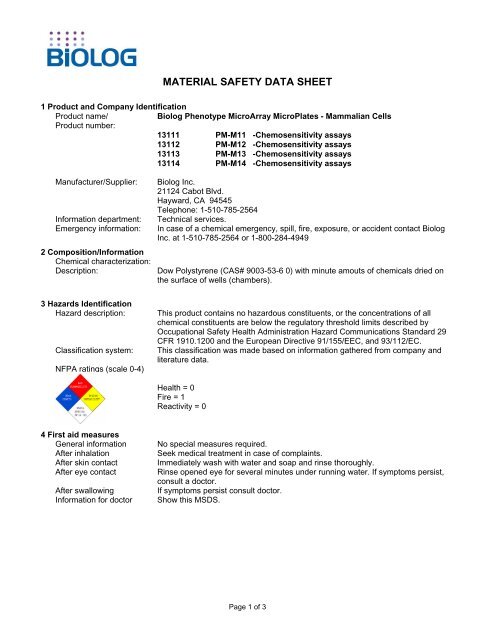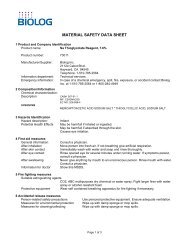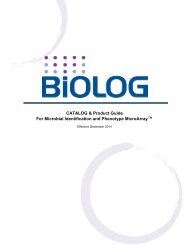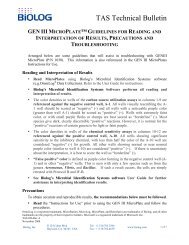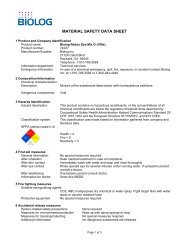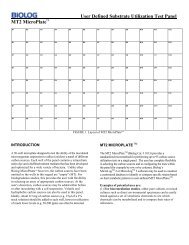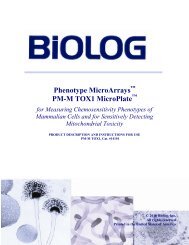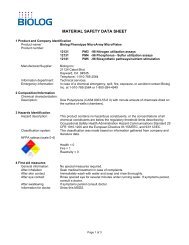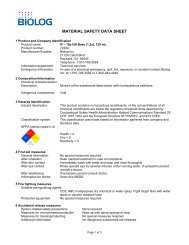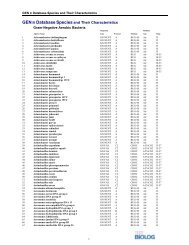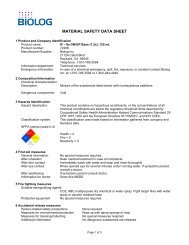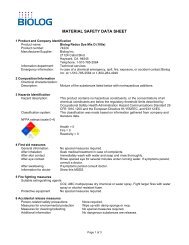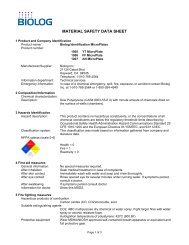MSDS - Biolog Inc.
MSDS - Biolog Inc.
MSDS - Biolog Inc.
Create successful ePaper yourself
Turn your PDF publications into a flip-book with our unique Google optimized e-Paper software.
MATERIAL SAFETY DATA SHEET1 Product and Company IdentificationProduct name/<strong>Biolog</strong> Phenotype MicroArray MicroPlates - Mammalian CellsProduct number:13111 PM-M11 -Chemosensitivity assays13112 PM-M12 -Chemosensitivity assays13113 PM-M13 -Chemosensitivity assays13114 PM-M14 -Chemosensitivity assaysManufacturer/Supplier:Information department:Emergency information:2 Composition/InformationChemical characterization:Description:<strong>Biolog</strong> <strong>Inc</strong>.21124 Cabot Blvd.Hayward, CA 94545Telephone: 1-510-785-2564Technical services.In case of a chemical emergency, spill, fire, exposure, or accident contact <strong>Biolog</strong><strong>Inc</strong>. at 1-510-785-2564 or 1-800-284-4949Dow Polystyrene (CAS# 9003-53-6 0) with minute amouts of chemicals dried onthe surface of wells (chambers).3 Hazards IdentificationHazard description:Classification system:NFPA ratings (scale 0-4)This product contains no hazardous constituents, or the concentrations of allchemical constituents are below the regulatory threshold limits described byOccupational Safety Health Administration Hazard Communications Standard 29CFR 1910.1200 and the European Directive 91/155/EEC, and 93/112/EC.This classification was made based on information gathered from company andliterature data.Health = 0Fire = 1Reactivity = 04 First aid measuresGeneral informationAfter inhalationAfter skin contactAfter eye contactAfter swallowingInformation for doctorNo special measures required.Seek medical treatment in case of complaints.Immediately wash with water and soap and rinse thoroughly.Rinse opened eye for several minutes under running water. If symptoms persist,consult a doctor.If symptoms persist consult doctor.Show this <strong>MSDS</strong>.Page 1 of 3
5 Fire fighting measuresHazardous products of combustionSuitable extinguishing agentsProtective equipment6 Accidental release measuresPerson-related safety precautionsMeasures for environmental protectionMeasures for cleaning/collectingAdditional informationCarbon oxides (CO, CO2)monoxide, soot.CO2, ABC multipurpose dry chemical or water spray. Fight largerfires with water spray or alcohol resistant foam.Autoignition temperature of polystyrene: 427C (800.6F)Wear MSHA/NIOSH approved self-contained breath apparatus orequivalent and full protective gear.None required.Wipe up with damp sponge or mop spills.No special measures required.No dangerous substances are releases.7 Handling and storageHandlingInformation on safe handlingInformation about protection againstexplosions and firesStorageRequirements to be met by storeroomsand receptaclesInformation about storage in one commonstorage facilityNo special measures required.No special measures required.2- 8 °C in the dark in dessicated packagesNo special measures required.8 Exposure controls and personal protectionComponents with limit values that requiremonitoring at the workplaceContains no substances with occupational exposure limit values.Personal protective equipmentGeneral protective and hygienic measures Use usual precautionary measures for handling chemicals.Breathing equipmentNone required.Protection of handsChemical resistant gloves (i.e. nitrile, or equivalent)Eye protectionSafety glassesBody protectionProtective work clothing (lab coat)9 Physical and chemical propertiesGeneral InformationFormSpecific gravityDensityEvaporation rateBoiling point/ Freezing pointSolubility in/ Miscibility with WaterPolystyrene MicroPlate containing dried chemicalsNot determinedNot determinedNot determinedNot determinedChemicals Soluble10 Stability and reactivityStabilityStableThermal decomposition/conditions to be avoidedNo decomposition if used according to specifications.Hazardous decompositions productsCarbon oxides (CO, CO2)monoxideHazardous polymerizationWill not occur.Page 2 of 3
11 Toxicological informationAcute toxicityNot determined.Primary irritant effectOn the skinReconstituted chemicals may cause irritation.On the eyeReconstituted chemicals may cause irritation.SensitizationNo sensitizing effects knownAdditional toxicological informationNone12 Ecological informationEcological effects Have not been thoroughly investigated, but currently none have been identified.13 Disposal considerationsProductRecommendation:Uncleaned packageRecommendation:Recommended cleaningAgent:Can be disposed of with solid waste.Dispose of material in accordance with federal(40 CFR 261.3), state and local requirements.This product is not considered RCRA hazardous waste.Disposal must be made according to state and federal regulations.Water, if necessary with cleaning agents.14 Transportation informationDOTConsidered to be non-hazardous for transport.IATAConsidered to be non-hazardous for air transport.15 Regulatory informationUnited States regulatory informationSARA ListedNo chemicals in this material are subject to the reporting requirements of SARATitle III, Section 302Canada regulatory informationWHMIS classification Classified in accordance with the hazard criteria of the CPR, and the <strong>MSDS</strong>contains all information required by the CPR.DSLNoNDSLNoCalifornia Proposition 65 – Chemicals known to cause cancerNone of the ingredients listedCalifornia Proposition 65 - Chemicals known to cause reproductive toxicityNone of the ingredients listed16 Other informationThe information, data, and recommendations contained herein are believed to be accurate. <strong>Biolog</strong>, <strong>Inc</strong>. makesno warranty of any kind whatever with respect thereto and disclaims all liability from reliance thereon. Wereserve the right to revise this <strong>MSDS</strong> periodically as new information becomes available.MS PM M11 - 14 MicroPlates: 13111; 13112 ; 13113 ; 13114Date: 14 MAR 2013Page 3 of 3


